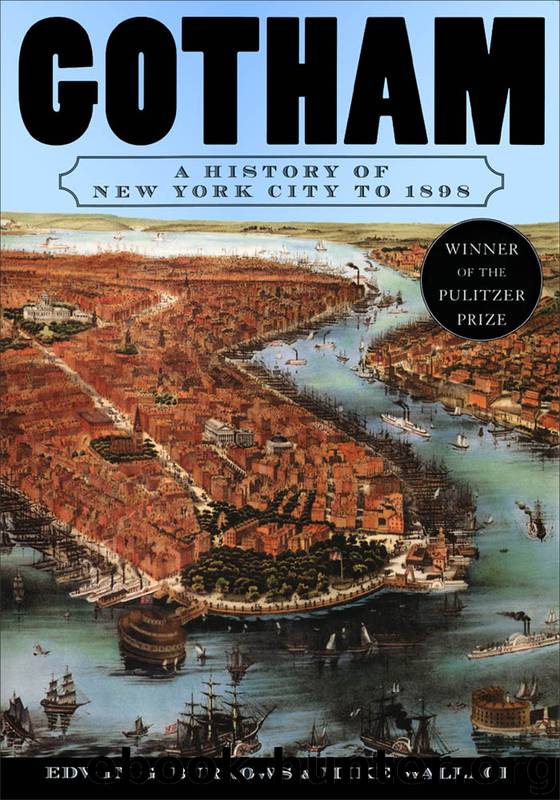Gotham by Burrows Edwin G. & Wallace Mike & Mike Wallace

Author:Burrows, Edwin G. & Wallace, Mike & Mike Wallace
Language: eng
Format: epub
Publisher: Oxford University Press
Published: 1999-08-19T04:00:00+00:00
RUDE B’HOYS
These divisions within the Catholic community were largely lost on nativists, from whose perspective it seemed that Hughes had constructed a monstrous phalanx and become its spiritual and temporal dictator. Their anxieties were further fueled by New York’s newfound favor with the Vatican and by some intemperate remarks Hughes made in November 1850 before leaving for Rome to receive the pallium of office from the pope. In a sermon at St. Patrick’s Cathedral, “The Decline of Protestantism and Its Causes,” Hughes announced the coming triumph of Rome over Protestant nations everywhere, including America. Such missionary fervor confirmed many nativists’ worst fears.
Beleaguered white artisans, in particular, facing an avalanche of immigrants and speeded-up proletarianization, reacted with hostility. Some organized the American Laboring Confederacy, whose paper, the Champion of American Labor, spoke out bitterly against the “swarms of needy adventurers, cut-throats and paupers of European jails and poor-houses, that, like the locusts of Egypt,” were ravaging the New York labor market. In trade after trade, an 1847 petition argued, employers had beaten down wages “by reason of their having the cheap pauper labor of Europe ready at hand, to work for that price if Americans refuse.”
Stopping or slowing the onrush seemed the only answer. If the government, through its tariff and other policies, could extend protection to “rich capitalists, to mammoth manufacturers, extensive railroad speculators and contractors in the public works,” why not protect workers by putting a tariff on people as well as commodities? In the boom era, however, most erstwhile allies were nowhere in sight or actively opposed to immigration restriction. Many old-timers recognized that the faucets of imported labor power were fixed in a wide-open position, that the New York working class would soon be dominated by immigrants, and that nativism was a strategy without a future. Some native-born artisans, accordingly, set out to make common cause with English Chartists, German socialists, and Irish nationalists. Others would nevertheless continue to press restrictionist demands, and street violence would flare up in the 1850s.
Whenever the crackle of street fighting subsided—or perhaps precisely when it was most furious—combative young American, German, and Irish workingmen discovered they had much in common. Many shared a visceral distaste for bourgeois culture, with its exaltation of piety and sobriety, self-control and industriousness, female domesticity and refined respectability. Many working-class men did embrace such virtues, of course, but others rejected definitions of male success that poorly paid proletarians found increasingly impossible to meet.
Some immigrants were drawn to the party of the refined; others joined the ranks of the rude boys—and transformed them into “b’hoys.” The b’hoy was a multiethnic construction, part native American rowdy, part Irish “jackeen,” part German “younker” (Kleindeutschland grocery clerks who expressed their Americanness by greasing their hair and wearing loud checked clothes to dance halls, rather than wearing the old costumes and singing the old songs with their elders in the beer halls).
This new youth culture fashioned its self-image not at work but at play—and the bastion of b’hoydom was the Bowery,
Download
This site does not store any files on its server. We only index and link to content provided by other sites. Please contact the content providers to delete copyright contents if any and email us, we'll remove relevant links or contents immediately.
| Africa | Americas |
| Arctic & Antarctica | Asia |
| Australia & Oceania | Europe |
| Middle East | Russia |
| United States | World |
| Ancient Civilizations | Military |
| Historical Study & Educational Resources |
Cat's cradle by Kurt Vonnegut(13970)
Pimp by Iceberg Slim(13014)
Underground: A Human History of the Worlds Beneath Our Feet by Will Hunt(11320)
4 3 2 1: A Novel by Paul Auster(11132)
The Radium Girls by Kate Moore(10976)
American History Stories, Volume III (Yesterday's Classics) by Pratt Mara L(4847)
Perfect Rhythm by Jae(4664)
Wiseguy by Nicholas Pileggi(4663)
The Fire Next Time by James Baldwin(4410)
Paper Towns by Green John(4219)
A Higher Loyalty: Truth, Lies, and Leadership by James Comey(4083)
Pale Blue Dot by Carl Sagan(4068)
The Mayflower and the Pilgrims' New World by Nathaniel Philbrick(3945)
The Doomsday Machine by Daniel Ellsberg(3781)
Too Much and Not the Mood by Durga Chew-Bose(3728)
Killers of the Flower Moon: The Osage Murders and the Birth of the FBI by David Grann(3683)
The Borden Murders by Sarah Miller(3627)
The Sympathizer by Viet Thanh Nguyen(3572)
Killing England by Bill O'Reilly(3497)
